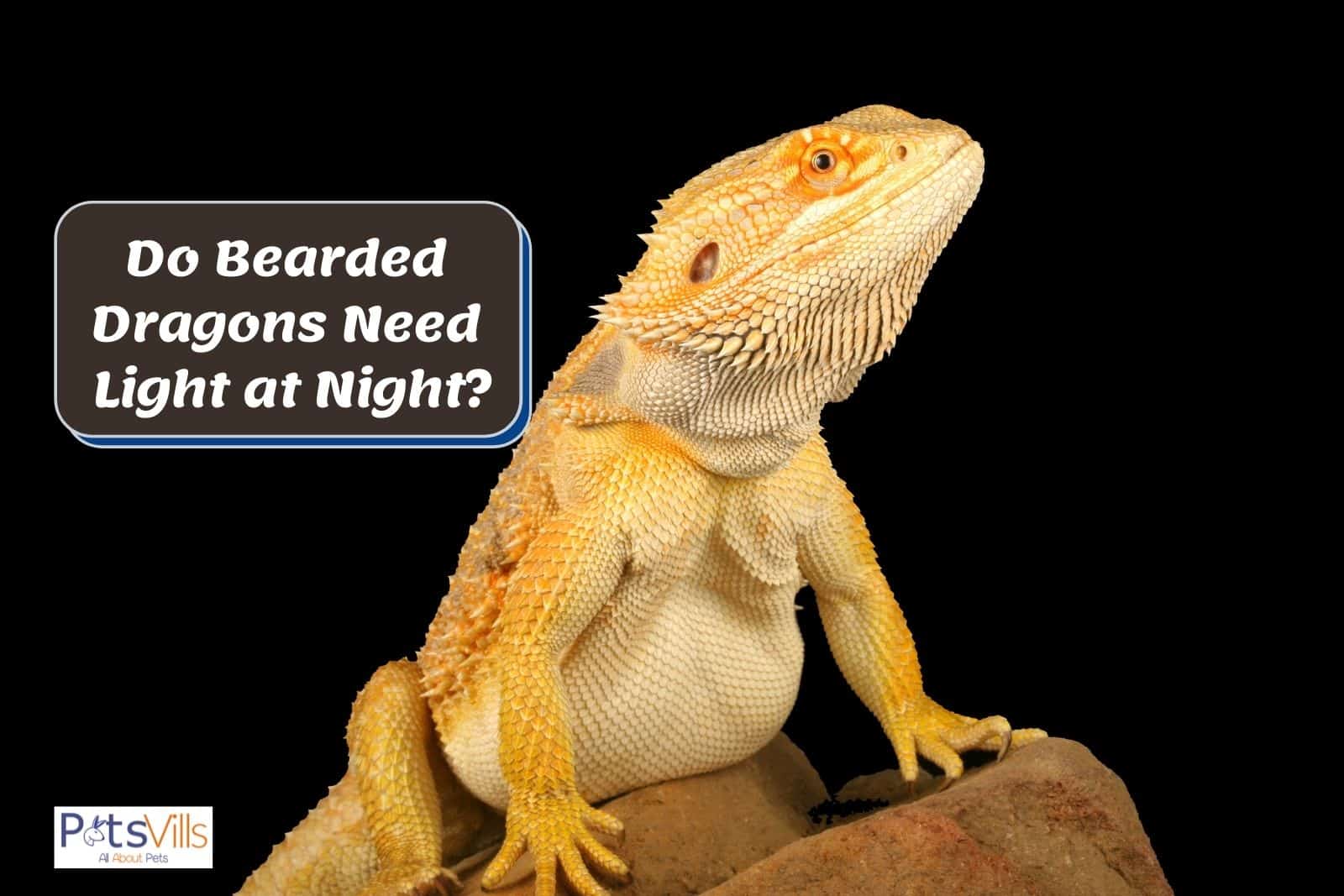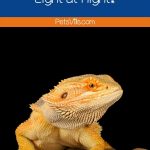Heat and light are essential elements in a bearded dragon habitat. However, most beardie owners want to know if a bearded dragon lighting at night is recommended.
So, as a bearded dragon owner, it is essential to know what to, how-to, and when to use the day UVB light on your bearded dragon.
READ MORE: Do Bearded Dragons Need UVB?
Table of Contents
Bearded Dragon Lighting at Night Requirements
Bearded dragons are easy to look after. Apart from monitoring their feeding habits and maintaining a clean environment, these lizard species need good day UVB light.
Ultraviolet-B (UVB) rays from direct sunlight are necessary to provide vitamin D3 to your bearded dragon and help it thermoregulate efficiently.
So, what are the night requirements of UVB light radiation for a bearded dragon?
Most beardies owners want to understand how much night light is sufficient for their pets. Luckily, we have the answer.
But before looking at the lighting requirements, you should understand your lizard’s natural behavior. All lizards are coldblooded creatures or ectothermic.
This means they need to absorb sufficient heat through external heat sources like the sun. [1] So, they require adequate radiant heat as much as they are adapted to low temperatures.
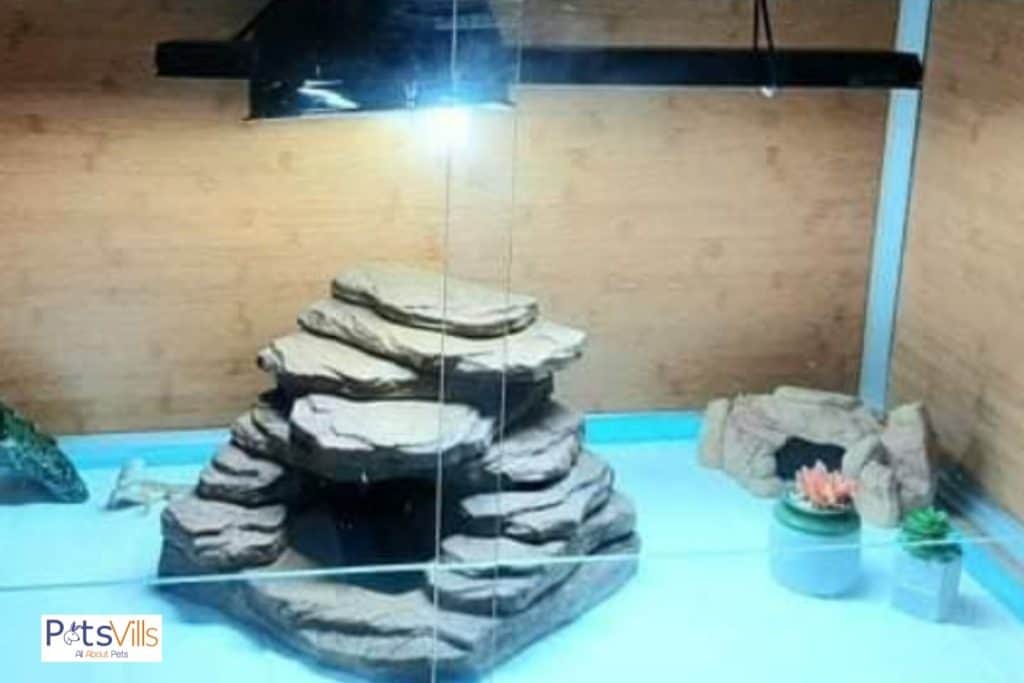
So, can a bearded dragon get too much UVB? Too much UVB light that is producing radiant heat at the same time will be uncomfortable for a bearded dragon.
The three essential night requirements for a bearded dragon include:
- 12-14 hours of adequate daytime UVA or day UVB light and not at night
- Most lighting sources should also function as an additional heat source during the day and not at night (UVB lighting)
- It is imperative to turn OFF the lights for another 12 hours at night
Here’s a great video explanation:
Bearded Dragon Origin
Bearded dragons originate from the arid Australian desert. The Arid Australian desert receives an adequate amount of sunlight for approximately 16 hours per day (in the summer months).
This explains why most bearded dragons are inclined towards heat and light naturally. They are adapted to arid conditions.
Therefore, if you have a bearded dragon, you need to replicate the same natural conditions to keep it comfortable and healthy.
This means you should add a sufficient amount of lighting to match the 14-hour long Australian desert conditions.
At night, turn off the light for another 12-14 hours. This particular pattern helps to complete the natural cycle.
Importance of UVA and UVB Lighting
Lighting is imperative for bearded dragons. The sun produces UVB radiation which is essential vitamin D3 nutrient provider.
Furthermore, vitamin D3 helps absorb calcium in the lizard’s body, thus improving its cardiovascular system, muscle contraction, and bone formation.
Check out this video:
Dangers of Insufficient Lighting
Insufficient lighting will lead to deprived calcium levels in the lizard’s body and cause hypocalcemia or Metabolic Bone Disease. [2] Especially for baby bearded dragons.
So, as an alternative to the sun’s rays, installing the recommended UVB light is necessary.
UVA lighting is also necessary for the bearded dragon tank. This is because your pet lizard will be sitting in its indoor tank for the better part of the day, as opposed to the other wild lizards that roam freely in the deserts.
Understanding the Bearded Dragon’s Day and Night Cycle
Understanding the beardie’s nocturnal behavior helps know if installing lights at night is appropriate. You might be surprised to find that a few species do not mind lighting at night.
Beardies are diurnals. This means bearded dragons will habitually come out during the day to recline or bask lazily and receive sunlight.
Nonetheless, beardies prefer to rest without disturbances or movements whatsoever sluggishly at night.
So, never expose your bearded dragon to UVB lights at night. Except on a few occasions, which we will discuss below.
According to animal research, a bearded dragon’s sleep schedule is at night. [3] These lizards sleep or rest peacefully when it is dark. They are sensitive to light like humans.
Here’s another great video:
What Are the Appropriate Lighting Hours of Nighttime Exposure?
You should know the precise amount of lighting hours recommended for your bearded dragon as the pet owner. [4]
How Short is Too Short?
Most bearded dragons can go a maximum of two days without lighting. However, this is discouraged.
Most reptile species (if not all) are daytime dwellers. They like adequate amounts of natural heat and light. The sun, apart from providing light, produces renewable energy.
The sun’s energy is as essential to a reptile’s body as humans.
So, you should know the exact amount of hours of nighttime exposure for your dragon. Here is a breakdown of the light hours depending on the season.
Spring and Summer
In summer or spring, the sun is mostly out for the better part of the day. So, you do not have to switch on the lighting at night.
Anywhere between 12-14 hours of nighttime exposure is ideal for your bearded dragon.
For instance, you can switch ON the lights from 6 AM to 6 PM or 6 AM to 8 PM during the warmer months.
Fall and Winter
In the winter months or fall season, it is vice versa. The sun is mostly off, and you need to switch on the UVB rays for your Bearded Dragon. [5]
A 14-16 hour cycle is ideal. But again, do not switch the light on at night.
What is the Appropriate Lighting Source?
Note that not all fluorescent lighting sources are appropriate for baby bearded dragons.
The best lighting for a beardie is the full-spectrum UVA light (also called basking area light). [6] This particular light is perfect because of its rays.
The rays do not penetrate the vivarium glass or plastic construction directly. Furthermore, this light does not produce excess heat compared to the other incandescent electric lighting bulbs or ceramic bulbs.
Also, always ensure that the light covers the vivarium tank sufficiently. Add a reflective surface to cover the UV light dome if it does not have one. This reflective surface ensures effective results.
The appropriate lighting should cover at least 2/3 of the bearded dragon tank. But a ¾ tank coverage is enough for baby bearded dragons. Never illuminate the entire enclosure.
Remember: Do not cover the entire beardie’s 40-gallon tank with UVA or UVB light. At least a ¼ uncovered part is enough for the “cooling zone.” [7]
Check this video for lighting setup breakdown:
Expert Tips:
- If you have to turn on the lighting at night, use a dimmable nighttime bulb or an incandescent bulb. Dimmable infrared bearded dragon bulbs can regulate the amount of light produced for your adult bearded dragon.
Here’s a great video to watch:
- If, for instance, your beardie did not get enough natural sunlight during the day, you can adjust the light bulb to its total capacity for about 4 to 6 hours.
- Bulb brands produce different watts. [8] Thus, always confirm the watts in a bulb before you pick a bulb for your dragon’s tank.
- Similarly, you should know the amount of light that corresponds to the size of the vivarium and the size of your pet beardie. A baby dragon requires 14-16 hours of adequate lighting. [9]
- Ordinary fluorescent bulbs can be too weak or strong for your adult bearded pet dragon.
- Excess light in the beardie’s tank can result in hormonal release and imbalance.
Exceptional Scenario Where Lighting is Ideal for the Tank at Night
Occasionally, you need to use a spot lamp or provide UVB lighting for your bearded dragon’s tank at night.
At night, the proper temperature [10] to keep the beardie warm should be about 21-24°C (70-75°F). This is according to research.
Here are two instances when providing nighttime lighting or using a UVB lamp is exceptional.
- When it is freezing, you should switch on the UVA light. Note that UVA lights not only produce light. These particular bulbs are a substitute for the bearded dragon heat lamps.
- They can emit anywhere between 5-7% UV exposure and help maintain the beardie’s body temperature.
- When the beardie’s tank is in the basement where night time temperatures at night are below the recommended 31-38°C basking area temperature and 24-29°C daytime temperature.
FAQs
Should I Turn my Bearded Dragons light ON or OFF at night?
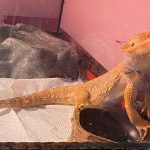
You should always turn off your bearded dragons’ light at night. Bearded dragons need total darkness and cooler temperatures to sleep at night.
I Left my Bearded Dragon’s Light ON All Night. What Do I Do?
You should turn it off for at least 12 hours in the morning. This approach helps to complete the recommended day and night light cycle. [11] Alternatively, install an automatic light timer.
What’s the Appropriate Light Cycle for my Pet Beardie?
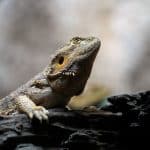
The correct lighting cycle is 12-14 hours of UVA lighting in summer and spring and 10-12 hours of UVA lighting in winter and autumn.
How Long Does a Bearded Dragon Usually Sleep?
Bearded dragons usually have 8 to 12 hours of sleep. Additionally, these lizard species sleep at night just like humans.
In Conclusion
So, according to research, bearded dragons do not require heat at night. However, understand adequate lighting hours and how to set up the perfect lighting source for your bearded dragon.
Resources
- 1. Bearded dragons [Internet]. Animals. 2019. Available from: https://www.nationalgeographic.com/animals/reptiles/facts/bearded-dragon
- 2. Pet Reptiles Need Vitamin D and Calcium for Bone Health [Internet]. College of Agricultural, Consumer and Environmental Sciences. Available from: https://aces.illinois.edu/news/pet-reptiles-need-vitamin-d-and-calcium-bone-health
- 3. Nairn AT. How Do Bearded Dragon Sleep & 5 Surprising Sleeping Habits [Internet]. 2020 [cited 2022 Jan 7]. Available from: https://beardeddragonsworld.com/bearded-dragon-sleep/
- 4. How Much Light Do Bearded Dragons Need? [Internet]. Clever Pet Owners. 2020 [cited 2022 Jan 7]. Available from: https://cleverpetowners.com/how-much-light-do-bearded-dragons-need/
- 5. Nairn AT. Simplifying Bearded Dragon Heating & Lighting Setup [Internet]. 2017 [cited 2022 Jan 7]. Available from: https://beardeddragonsworld.com/bearded-dragon-heating-and-lights/
- 6. Full Spectrum UV Lighting [Internet]. www.lllreptile.com. [cited 2022 Jan 7]. Available from: https://www.lllreptile.com/articles/101-full-spectrum-uv-lighting/
- 7. Proper UVA/UVB Lighting for 40 Gallon [Internet]. Bearded Dragon Forum. [cited 2022 Jan 7]. Available from: https://www.beardeddragonforum.com/threads/proper-uva-uvb-lighting-for-40-gallon.21146/
- 8. NPR Choice page [Internet]. Npr.org. 2019. Available from: https://www.npr.org/2014/01/28/267185097/in-the-dark-about-picking-a-light-bulb-this-faq-can-help
- 9. Bearded dragon light schedule [Internet]. Bearded Dragon .org. [cited 2022 Jan 7]. Available from: https://www.beardeddragon.org/threads/bearded-dragon-light-schedule.225935/
- 10. I Left My Bearded Dragons’ Lights on All Night! (Solved) – VivariumTips [Internet]. vivariumtips.com. 2020 [cited 2022 Jan 7]. Available from: https://vivariumtips.com/i-left-my-bearded-dragons-lights-on-all-night
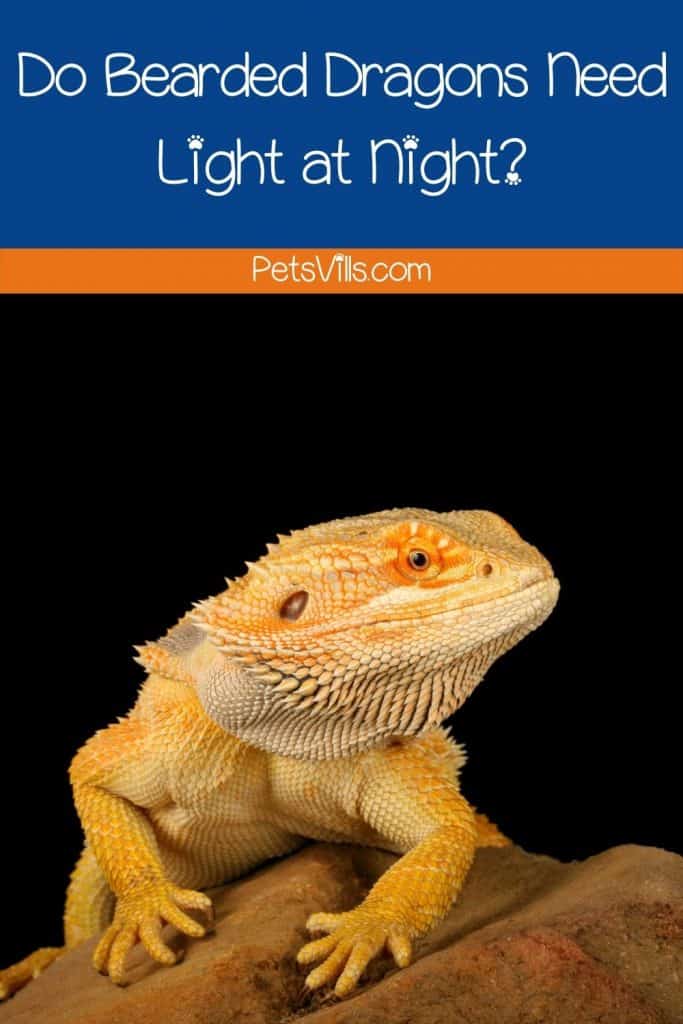
Do you light your bearded dragon at night? Let us know your thoughts below!
Alina Hartley is a small-town girl with a ginormous love of bearded dragons. It all started with Winchester, a baby bearded who was abandoned at the shelter by his former owners because of a birth defect that caused one front leg to be shorter than the other. Alina originally went to the shelter looking for a guinea pig, but one look at Winchester and it was love at first sight. From that day on, Alina has dedicated her life to learning everything she can about bearded dragons. She loves helping new beardie parents start their incredible journey with these magnificent reptiles.
Follow her on:
LINKEDIN
TWITTER.
Read her latest articles HERE
Learn more about her HERE.

